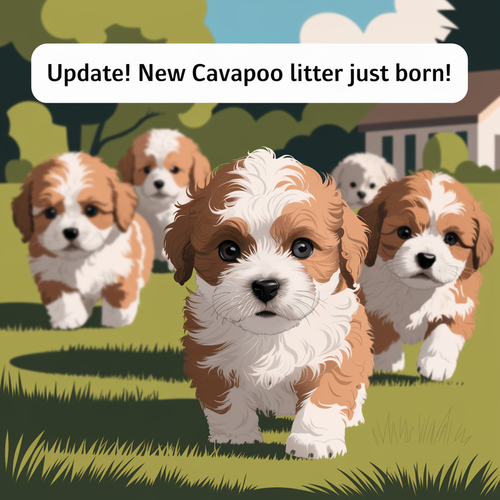The Ruby Cavalier King Charles Spaniel is a breed that captures hearts with its affectionate nature and charming appearance. Known for their rich, ruby-colored coat, these dogs are not just pets but become an integral part of any family they join. Let's delve into the world of this delightful breed.
Current Availability of Ruby Cavalier King Charles Spaniels
At Weaver Family Farms Puppies, we occasionally have Ruby Cavalier King Charles Spaniel puppies available for adoption. If you're interested in welcoming one of these adorable puppies into your home, it's a good idea to check our current listings for availability. We ensure that each puppy is ready to become a loving addition to your family.

Characteristics of the Ruby Cavalier King Charles Spaniel
- Appearance: The Ruby Cavalier King Charles Spaniel is known for its beautiful, solid ruby-red coat. They have expressive, dark round eyes and a sweet expression that is hard to resist.
- Temperament: This breed is renowned for its friendly and affectionate nature. They are great with families, including those with children, and they thrive on companionship.
- Size and Lifespan: They are a small breed, typically weighing between 13 to 18 pounds. With proper care, their lifespan ranges from 9 to 14 years.
Why Choose a Ruby Cavalier King Charles Spaniel?
- Ideal Family Pet: Their gentle and loving temperament makes them an ideal pet for families.
- Adaptability: They adapt well to various living situations, whether it’s a house with a yard or an apartment.
- Companionship: This breed is known for forming strong bonds with their owners, offering companionship and comfort.
The Ruby Cavalier King Charles Spaniel is not just a dog breed; it's a bundle of joy and love wrapped in a beautiful ruby coat. As a passionate enthusiast and provider of these wonderful companions at Weaver Family Farms Puppies, I've had the pleasure of seeing the positive impact these dogs have on their owners' lives. Let's explore more about what makes the Ruby Cavalier King Charles Spaniel a cherished pet.
Understanding the Breed's History and Background
The Cavalier King Charles Spaniel has a rich history, with its roots tracing back to the royal courts of England. The Ruby variety, with its distinctive solid red coat, is one of the four recognized colors of the breed. These dogs have always been prized for their elegant appearance and affectionate nature, making them favorites of nobility and dog lovers alike.
Health and Care for Ruby Cavalier King Charles Spaniels
- Regular Exercise: Despite their small size, Ruby Cavaliers are energetic and enjoy regular walks and playtime.
- Health Checks: It's important to keep up with regular veterinary check-ups, as the breed can be prone to certain health issues like heart conditions and hip dysplasia.
- Grooming Needs: Their beautiful ruby coat requires regular grooming to keep it in top condition. Regular brushing and occasional professional grooming will keep their coat shiny and healthy.

The Temperament That Wins Hearts
Ruby Cavalier King Charles Spaniels are known for their gentle and affectionate temperament. They are:
- Friendly: They get along well with people of all ages, including children, and are friendly towards other pets.
- Loyal Companions: They form strong bonds with their owners, often following them around the house and seeking cuddles.
- Adaptable: They adapt well to different lifestyles, whether you lead a more active life or prefer quiet evenings at home.
Activities Suitable for Ruby Cavaliers
These dogs enjoy activities that involve interaction with their owners. They are great companions for walks in the park, and they also enjoy gentle playtime. Due to their social nature, they thrive in environments where they can interact with people and other dogs.
Why a Ruby Cavalier King Charles Spaniel Might Be Right for You
If you're looking for a pet that is affectionate, adaptable, and has a regal appearance, the Ruby Cavalier King Charles Spaniel is an excellent choice. They are suitable for families, singles, and seniors alike, making them a versatile companion for various lifestyles.
As a lover and provider of Ruby Red Cavalier King Charles Spaniels, I often encounter questions from prospective owners about this delightful breed. Here are some common queries and my insights, which might help you understand these charming dogs better.
What Is the Temperament of a Ruby Red Cavalier King Charles Spaniel?
Ruby Red Cavalier King Charles Spaniels are known for their affectionate, friendly, and gentle temperament. They are great with families, including children, and are known for their sociable nature. These dogs thrive on companionship and love being part of family activities.
How Much Exercise Does a Ruby Red Cavalier Need?
Despite their small size, Ruby Red Cavaliers are quite active and enjoy regular exercise. A daily walk and some playtime are usually sufficient to keep them happy and healthy. They also enjoy interactive games and activities that stimulate their mind.
Are Ruby Red Cavaliers Good with Other Pets?
Yes, Ruby Red Cavalier King Charles Spaniels generally get along well with other pets. They are a sociable breed and can coexist peacefully with other dogs and even cats, especially if they are raised together or properly introduced.
What Are the Grooming Needs of This Breed?
Ruby Red Cavaliers have a medium-length coat that requires regular grooming. Brushing a few times a week is recommended to prevent tangles and mats. They also need regular ear cleaning and nail trimming, along with routine dental care.
Is the Ruby Red Cavalier King Charles Spaniel a Healthy Breed?
While Ruby Red Cavaliers are generally healthy, they can be prone to certain health issues like mitral valve disease, syringomyelia, and hip dysplasia. Regular veterinary check-ups and a healthy lifestyle are important to maintain their health.
How Well Do Ruby Red Cavaliers Adapt to Apartment Living?
Ruby Red Cavaliers are adaptable and can live comfortably in apartments as long as they get their daily exercise. They are not overly noisy, which makes them suitable for apartment living. However, they do crave companionship and should not be left alone for long periods.








